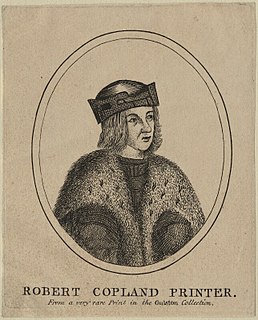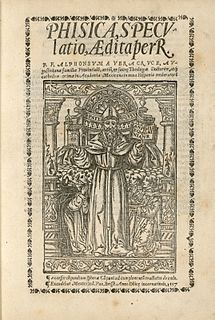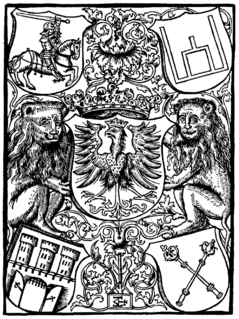 W
WLaurence Andrewe, was a translator and printer. He was from Calais, then controlled by the English. He translated in 1510 ‘The noble life and natures of man, of besets, serpent's, fowles & fishes, yt be made known [col.] Translated be me Laurens Andrewe of the towne of Calis, in the famous cite of Andwarpe. Emprented be me John of Doesborowe [n.d.]’ folio. He probably learned the art of printing from John Doesborowe or Peter Treveris, and practised for some time in London in Fleet Street, at the Golden Cross by Fleet Bridge.
 W
WJohann Balhorn the Younger was a German printer in Lübeck. He followed his father, Johann Balhorn the Elder in the printing trade, from whom he took over the printing house. Both used as a monogram the pictured printer's mark and a seal with a horn and three balls. In a play on their name the German word verballhornen, which means "parody", was coined.
 W
WChristopher Barker (c.1529–1599) was the printer to Queen Elizabeth I. He was also the father of a printing dynasty that included his son Robert Barker, his grandsons Robert Constable and Francis Constable, and Richard Constable who is believed to be his grandson. He is most well-known for printing many editions of English Bibles during the Elizabethan Age, notably the Geneva Bible and the so-called Bishop's Bible. He was the official printer of the court of Elizabeth I of England and held exclusive patents to print Bibles.
 W
WThomas Berthelet was a London printer, probably from France. His surname was also variously spelt Berthelot and Berthelett. Berthelet was to become King's Printer and King's Bookbinder for Henry VIII. His name was Englished as "Bartlett".
 W
WZacharias Calliergi was a Greek Renaissance humanist and scholar.
 W
WThe Chepman and Myllar Press was the first printing press to be established in Scotland.
 W
WWalter Chepman (d.1532) was a Scottish merchant, notary and civil servant active in the late fifteenth and early sixteenth centuries. Chepman served at the Scottish court during the reigns of James IV and James V. In partnership with Androw Myllar he established Scotland's first printing press in 1508. Chepman was also a significant patron of Saint Giles' Kirk in Edinburgh.
 W
WBibliothèque bleue is a type of ephemera and popular literature published in Early Modern France, comparable to the English chapbook and the German Volksbuch. As was the case in England and Germany, that literary format appealed to all levels of French society, transcending social, sex, and age barriers.
 W
WSimon de Colines was a Parisian printer and one of the first printers of the French Renaissance. He was active in Paris as a printer and worked exclusively for the University of Paris from 1520 to 1546. In addition to his work as a printer; Colines worked as an editor, publisher, and punchcutter. Over the course of his lifetime, he published over 700 separate editions. Colines used elegant roman and italic types and a Greek type, with accents, that were superior to their predecessors. These are now called French old-style, a style that remained popular for over 200 years and revived in the early 20th century. He used rabbits, satyrs, and philosophers as his pressmark.
 W
WRobert Copland, English printer and author, is said to have been a servant of William Caxton, and certainly worked for Wynkyn de Worde. The first book to which his name is affixed as a printer is The Boke of Justices of Peace (1515), at the sign of the Rose Garland, in Fleet Street, London. Anthony à Wood supposed, on the ground that he was more educated than was usual in his trade, that he had been a poor scholar of Oxford.
 W
WLodewijk Elzevir, originally Lodewijk or Louis Elsevier or Elzevier, was a printer, born in the city of Leuven. He was the founder of the House of Elzevir, which printed, for example, "Two New Sciences", a work of Galileo, at a time when his work was suppressed for religious reasons. Although the House of Elzevir ceased publishing in 1712, the modern Dutch Elsevier company was founded in 1880 and took its name from the historic Dutch publishing house.
 W
WHieronymus Froben (1501–1563) was a famous pioneering printer in Basel and the eldest son of Johann Froben. He was educated at the University of Basel and traveled widely in Europe.
 W
WChristoph Froschauer was the first printer in Zurich, notably for printing the Froschauer Bible, the Zwinglian Bible translation. His workshop is the nucleus of the Orell Füssli publishing house.
 W
WJohannes (Hans) Grüninger (1455–1533) was a German printer whose career spanned from 1482 to 1533 and produced up to 500 publications. Grüninger was one of the single most prolific printers of Strasbourg, printing up to 80 books a year. While a great deal of his publications were Catholic, he managed to print a great variety of works ranging from humanist to scientific texts. His work was fairly equally representative of both Latin and the vernacular; about 39% of his works were printed in Latin and the remaining 61% in German.
 W
WCharlotte Guillard was the first woman printer of importance. Guillard worked at the famous Soleil d'Or printing house from 1502 until her death. Annie Parent described her as a "notability of the Rue Saint-Jacques", the street where the shop was located in Paris, France. She became one of the most important printers of the Latin Quarter area in the city of Paris. As a woman, she was officially active with her own imprint during her two widowhood periods, that is to say in 1519–20, and in 1537–57. While she was not the first woman printer, succeeding both Anna Rugerin of Augsburg (1484) and Anna Fabri of Stockholm (1496), she was the first woman printer with a significantly known career.
 W
WTrojan Gundulić was a merchant and printer from the Republic of Ragusa who is remembered for his participation in the printing of the first book in Belgrade, The Four Gospels ("Četverojevanđelje").
 W
WGáspár Heltai was a Transylvanian Saxon writer and printer. His name possibly derives from the village Heltau. Despite being a German native speaker he published many books in Hungarian from his print-shop. The brother of his son-in-law was Ferenc Dávid, Nontrinitarian and Unitarian preacher and the founder of the Unitarian Church of Transylvania.
 W
WLevinus Hulsius or Levin Hulsius He was a maker and dealer of fine scientific instruments; publisher and printer; linguist and lexicographer; wrote extensively on the construction of geometrical instruments. Although he was born in Flanders he lived and worked in the Netherlands and Germany.
 W
WJakov of Kamena Reka or Jakov Krajkov was a Venetian printer. The information about his life is scarce. It is known he was from a former village called Kamena Reka or Stone River, according to him near the town of Kolasia, in Osogovo, Macedonia. It is assumed that the village could be Makedonska Kamenica in present-day North Macedonia, or Kamenichka Skakavitsa, in present-day Bulgaria, both placed in an area in Osogovo called Kamenitsa, near the town of Kyustendil. Also, in some works his birthplace is connected with Kamena Reka, near Kolasin in Herzegovina in today Montenegro. Nevertheless, that view is criticized as 19th century Šafárik's misinterpretation of the medieval name of Kyustendil (Kolasia) with that of the town of Kolasin, that was adopted afterwards by other researchers. His family members had a long tradition of being Christian priests. In his youth Kraikov was a copyist of Church Slavonic books in the Osogovo Monastery "St. Joakim Osogovski". Then he went to Sofia, where in a local Church school, Kraikov deepened his literary knowledge. However some researchers maintain that Jakov of Sofia and Jakov of Kamena Reka are different historical persons.
 W
WGuillaume Le Bé was a French punchcutter and engraver who specialised in Hebrew typefaces.
 W
WHieromonk Makarije is the founder of Serbian and Romanian printing, having printed the first book in Serbian language and the first book in the territory of Walachia.
 W
WStefan Marinović, also known as Stefan of Scutari was a 16th-century Serb printer from Scutari (Shkodër). Marinović printed his books first in Venice and then in Scutari. He always emphasized that he was from Scutari.
 W
WFrančesko Ratkov Micalović was an early 16th-century Ragusan printer who printed the first books on vernacular language of population of contemporary Ragusa.
 W
WMichelle Nicod was a book printer and publisher, active in Geneva in 1585–1618.
 W
WJan Moretus, also John Moerentorf or 'Joannes Moretus', was a Flemish printer.
 W
WAndrow Myllar was the first Scottish printer.
 W
WGiovanni Paoli, better known as Juan Pablos, a native of Lombardy, was the first documented printer in the Americas when he started printing in Mexico in 1539.
 W
WChristophe Plantin was an influential French Renaissance humanist and book printer and publisher living and working in Antwerp.
 W
WRichard Pynson was one of the first printers of English books. Born in Normandy he moved to London, where he became one of the leading printers of the generation following William Caxton. His books were printed to a high standard of craftsmanship, and his Morton Missal (1500) is regarded as among the finest books printed in England in the period.
 W
WRaphelengius was a family of printers in 16th and 17th century Flanders. The family name is the Latinized form of the Dutch family name van Ravelingen, known from the Flemish place name Ravelingen, today a village in the Belgian harbor city Ostend.
 W
WFrancysk Skaryna was a Ruthenian humanist, physician, and translator. He is known to be one of the first book printers in the Grand Duchy of Lithuania and in all of Eastern Europe, laying the groundwork for the development of the Belarusian izvod of the Church Slavonic language.
 W
WVincenzo Valgrisi, also known under his Latinized name as Vicentius Valgrisius, was a French-born printer active primarily in Venice in the 16th-century.
 W
WThomas Vautrollier or Vautroullier was a French Huguenot refugee who became a printer in England and, briefly, in Scotland.
 W
WMayken Verhulst, also known as Marie Bessemers, was a sixteenth-century miniature, tempera and watercolor painter, identified by Lodovico Guicciardini in 1567 as one of the four most important female artists in the Low Countries. She was actively engaged in the workshop of her husband, Pieter Coecke van Aelst, posthumously publishing his works. While she is recognized as an exceptionally skilled artist, little is known about her works or life as there are few surviving attributable sources of information.
 W
WHieronymus Vietor was a printer and publisher born in Silesia and active in Vienna and Kraków. Famous for the quality and quantity of his prints, he is considered one of the most important early book printers in Poland, also because he was the first to regularly print in Polish. He is also known as Hieronymus Philovallensis or Hieronymus Doliarius, or in Polish as Hieronim Wietor or Büttner.
 W
WBožidar Vuković was one of the first printers and editors of Serbian books in Montenegro. He founded the famous Vuković printing house in Venice. His printing house was operational in two periods. In first period 1519–21 three books were printed. In the second period 1536–40 two books were printed.
 W
WWynkyn de Worde was a printer and publisher in London known for his work with William Caxton, and is recognised as the first to popularise the products of the printing press in England.
 W
WJerolim Zagurović was a Serbian-Venetian printer of Serbian Cyrillic books (srbulje). Zagurović and Vićenco Vuković were the last printers of srbulje books.